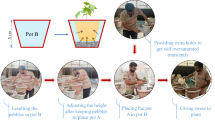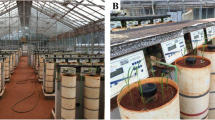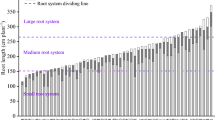Abstract
Main conclusions
A novel image-based screening method for precisely identifying genotypic variations in rapeseed RSA under waterlogging stress was developed. Five key root traits were confirmed as good indicators of waterlogging and might be employed in breeding, particularly when using the MFVW approach.
Abstract
Waterlogging is a vital environmental factor that has detrimental effects on the growth and development of rapeseed (Brassica napus L.). Plant roots suffer from hypoxia under waterlogging, which ultimately confers yield penalty. Therefore, it is crucially important to understand the genetic variation of root system architecture (RSA) in response to waterlogging stress to guide the selection of new tolerant cultivars with favorable roots. This research was conducted to investigate RSA traits using image-based screening techniques to better understand how RSA changes over time during waterlogging at the seedling stage. First, we performed a t-test by comparing the relative root trait value between four tolerant and four sensitive accessions. The most important root characteristics associated with waterlogging tolerance at 12 h are total root length (TRL), total root surface area (TRSA), total root volume (TRV), total number of tips (TNT), and total number of forks (TNF). The root structures of 448 rapeseed accessions with or without waterlogging showed notable genetic diversity, and all traits were generally restrained under waterlogging conditions, except for the total root average diameter. Additionally, according to the evaluation and integration analysis of 448 accessions, we identified that five traits, TRL, TRSA, TRV, TNT, and TNF, were the most reliable traits for screening waterlogging-tolerant accessions. Using analysis of the membership function value (MFVW) and D-value of the five selected traits, 25 extremely waterlogging-tolerant materials were screened out. Waterlogging significantly reduced RSA, inhibiting root growth compared to the control. Additionally, waterlogging increased lipid peroxidation, accompanied by a decrease in the activities of superoxide dismutase (SOD), peroxidase (POD), and catalase (CAT). This study effectively improves our understanding of the response of RSA to waterlogging. The image-based screening method developed in this study provides a new scientific guidance for quickly examining the basic RSA changes and precisely predicting waterlogging-tolerant rapeseed germplasms, thus expanding the genetic diversity of waterlogging-tolerant rapeseed germplasm available for breeding.





Similar content being viewed by others
Data availability
The data analyzed during this study are included in this manuscript and its supplementary files.
Abbreviations
- MDA:
-
Malondialdehyde
- MFVW:
-
Membership function value of waterlogging tolerance
- PRL:
-
Primary root length
- RFW:
-
Root fresh weight
- RSA:
-
Root system architecture
- SFW:
-
Shoot fresh weight
- SOD:
-
Superoxide dismutase
- TARD:
-
Total average root diameter
- TNT:
-
Total number of tips
- TNF:
-
Total number of forks
- TRL:
-
Total root length
- TRSA:
-
Total root surface area
- TRV:
-
Total root volume
- WLI:
-
Waterlogging tolerant index
References
Ahmad N, Su B, Ibrahim S et al (2022) Deciphering the genetic basis of root and biomass traits in rapeseed (Brassica napus L.) through the integration of GWAS and RNA-Seq under nitrogen stress. Int J Mol Sci 23:7958. https://doi.org/10.3390/ijms23147958
Araki H, Morita S, Tatsumi J, Iijima M (2002) Physiol-morphological analysis on axile root growth in upland rice. Plant Prod Sci 5:286–293. https://doi.org/10.1626/pps.5.286
Ateeq M, Khan AH, Zhang D et al (2023) Comprehensive physio-biochemical and transcriptomic characterization to decipher the network of key genes under waterlogging stress and its recuperation in Prunus persica. Tree Physiol 43:1265–1283. https://doi.org/10.1093/treephys/tpad029
Atieno J, Li Y, Langridge P et al (2017) Exploring genetic variation for salinity tolerance in chickpea using image-based phenotyping. Sci Rep 7:1300. https://doi.org/10.1038/s41598-017-01211-7
Beyer S, Daba S, Tyagi P et al (2019) Loci and candidate genes controlling root traits in wheat seedlings-a wheat root GWAS. Funct Integr Genom 19:91–107. https://doi.org/10.1007/s10142-018-0630-z
Bouma TJ, Nielsen KL, Koutstaal B (2000) Sample preparation and scanning protocol for computerized analysis of root length and diameter. Plant Soil 218:185–196. https://doi.org/10.1023/a:1014905104017
Burton AL, Johnson JM, Foerster JM et al (2014) QTL mapping and phenotypic variation for root architectural traits in maize (Zea mays L.). Theor Appl Genet 127:2293–2311. https://doi.org/10.1007/s00122-014-2353-4
Dun X, Tao Z, Wang J et al (2016) Comparative transcriptome analysis of primary roots of Brassica napus seedlings with extremely different primary root lengths using RNA sequencing. Front Plant Sci 7:1238. https://doi.org/10.3389/fpls.2016.01238
Giehl RF, Gruber BD, Von Wirén N (2014) It’s time to make changes: modulation of root system architecture by nutrient signals. J Exp Bot 65:769–778. https://doi.org/10.1093/jxb/ert421
Guo J, Li C, Zhang X et al (2020) Transcriptome and GWAS analyses reveal candidate gene for seminal root length of maize seedlings under drought stress. Plant Sci 292:110380. https://doi.org/10.1016/j.plantsci.2019.110380
Hairmansis A, Berger B, Tester M, Roy SJ (2014) Image-based phenotyping for non-destructive screening of different salinity tolerance traits in rice. Rice 7:16. https://doi.org/10.1186/s12284-014-0016-3
Ibrahim S, Ahmad N, Kuang L et al (2022) Genome-wide association studies of root-related traits in Brassica napus L. under low-potassium conditions. Plants 11:1826. https://doi.org/10.3390/plants11141826
Jitsuyama Y (2015) Morphological root responses of soybean to rhizosphere hypoxia reflect waterlogging tolerance. Can J Plant Sci 95:999–1005. https://doi.org/10.4141/CJPS-2014-370
Khan MN, Zhang J, Luo T et al (2019) Morpho-physiological and biochemical responses of tolerant and sensitive rapeseed cultivars to drought stress during early seedling growth stage. Acta Physiol Plant 41:2. https://doi.org/10.1007/s11738-019-2812-2
Kitomi Y, Hanzawa E, Kuya N et al (2020) Root angle modifications by the DRO1 homolog improve rice yields in saline paddy fields. Proc Natl Acad Sci USA 117:21242–21250. https://doi.org/10.1073/pnas.2005911117
Kushwah A, Bhatia D, Singh G et al (2021) Phenotypic evaluation of genetic variability and selection of yield contributing traits in chickpea recombinant inbred line population under high temperature stress. Physiol Mol Biol Plants 27:747–767. https://doi.org/10.1007/s12298-021-00977-5
Li F, Chen B, Xu K et al (2014) Genome-wide association study dissects the genetic architecture of seed weight and seed quality in rapeseed (Brassica napus L.). DNA Res 21:355–367. https://doi.org/10.1093/dnares/dsu002
Li R, Zeng Y, Xu J et al (2015) Genetic variation for maize root architecture in response to drought stress at the seedling stage. Breed Sci 65:298–307. https://doi.org/10.1270/jsbbs.65.298
Li H, Zhang L, Hu J et al (2017) Genome-wide association mapping reveals the genetic control underlying branch angle in rapeseed (Brassica napus L.). Front Plant Sci 8:1054. https://doi.org/10.3389/fpls.2017.01054
Li B, Feng Y, Zong Y et al (2020) Elevated CO2-induced changes in photosynthesis, antioxidant enzymes and signal transduction enzyme of soybean under drought stress. Plant Physiol Biochem 154:105–114. https://doi.org/10.1016/j.plaphy.2020.05.039
Li Z, Bai D, Zhong Y et al (2022) Full-length transcriptome and RNA-seq analyses reveal the mechanisms underlying waterlogging tolerance in kiwifruit (Actinidia valvata). Int J Mol Sci 23:3237. https://doi.org/10.3390/ijms23063237
Magalhães PC, de Souza TC, Cantão FRO (2011) Early evaluation of root morphology of maize genotypes under phosphorus deficiency. Plant Soil Environ 57:135–138. https://doi.org/10.17221/360/2010-pse
Meister R, Rajani MS, Ruzicka D, Schachtman DP (2014) Challenges of modifying root traits in crops for agriculture. Trends Plant Sci 19:779–788. https://doi.org/10.1016/j.tplants.2014.08.005
Nabloussi A, Bahri H, Lakbir M et al (2019) Assessment of a set of rapeseed (Brassica napus L.) varieties under waterlogging stress at different plant growth stages. OCL 26:36. https://doi.org/10.1051/ocl/2019033
Pan J, Sharif R, Xu X, Chen X (2021) Mechanisms of waterlogging tolerance in plants: research progress and prospects. Front Plant Sci 11:627331. https://doi.org/10.3389/fpls.2020.627331
Phukan UJ, Mishra S, Shukla RK (2016) Waterlogging and submergence stress: affects and acclimation. Crit Rev Biotechnol 36:956–966. https://doi.org/10.3109/07388551.2015.1064856
Ploschuk RA, Miralles DJ, Colmer TD et al (2018) Waterlogging of winter crops at early and late stages: impacts on leaf physiology, growth and yield. Front Plant Sci 9:1863. https://doi.org/10.3389/fpls.2018.01863
Richard CA, Hickey LT, Fletcher S et al (2015) High-throughput phenotyping of seminal root traits in wheat. Plant Methods 11:13. https://doi.org/10.1186/s13007-015-0055-9
Sakazono S, Nagata T, Matsuo R et al (2014) Variation in root development response to flooding among 92 soybean lines during early growth stages. Plant Prod Sci 17:228–236. https://doi.org/10.1626/pps.17.228
Sauter M (2013) Root responses to flooding. Curr Opin Plant Biol 16:282–286. https://doi.org/10.1016/j.pbi.2013.03.013
Shaw RE, Meyer WS, McNeill A, Tyerman SD (2013) Waterlogging in Australian agricultural landscapes: a review of plant responses and crop models. Crop Pasture Sci 64:549–562. https://doi.org/10.1071/CsongP13080
Song L, Prince S, Valliyodan B et al (2016) Genome-wide transcriptome analysis of soybean primary root under varying water-deficit conditions. BMC Genom 17:57. https://doi.org/10.1186/s12864-016-2378-y
Su J, Zhang F, Li P et al (2016) Genetic variation and association mapping of waterlogging tolerance in chrysanthemum. Planta 244:1241–1252. https://doi.org/10.1007/s00425-016-2583-6
Su J, Yang Y, Zhang X et al (2023) Evaluation of wild chrysanthemums for waterlogging tolerance at the seedling stage. Euphytica 219:1–10. https://doi.org/10.1007/s10681-022-03148-z
Uga Y, Sugimoto K, Ogawa S et al (2013) Control of root system architecture by DEEPER ROOTING1 increases rice yield under drought conditions. Nat Genet 45:1097–1102. https://doi.org/10.1038/ng.2725
Valliyodan B, Ye H, Song L et al (2017) Genetic diversity and genomic strategies for improving drought and waterlogging tolerance in soybeans. J Exp Bot 68:1835–1849. https://doi.org/10.1093/jxb/erw433
Voesenek LA, Sasidharan R (2013) Ethylene-and oxygen signalling-drive plant survival during flooding. Plant Biol 15:426–435. https://doi.org/10.1111/plb.12014
Wang J, Kuang L, Wang X et al (2019) Temporal genetic patterns of root growth in Brassica napus L. revealed by a low-cost, high-efficiency hydroponic system. Theor Appl Genet 132:2309–2323. https://doi.org/10.1007/s00122-019-03356-7
Weng J, Li P, Rehman A et al (2021) Physiological response and evaluation of melon (Cucumis melo L.) germplasm resources under high temperature and humidity stress at seedling stage. Sci Hortic 288:110317. https://doi.org/10.1016/j.scienta.2021.110317
Wu H, Guo J, Wang C et al (2019) An effective screening method and a reliable screening trait for salt tolerance of Brassica napus at the germination stage. Front Plant Sci 10:530. https://doi.org/10.3389/fpls.2019.00530
Zahra N, Hafeez MB, Shaukat K et al (2021) Hypoxia and anoxia stress: plant responses and tolerance mechanisms. J Agron Crop Sci 207:249–284. https://doi.org/10.1111/jac.12471
Zhang F, Xiao X, Yan G et al (2018) Association mapping of cadmium-tolerant QTLs in Brassica napus L. and insight into their contributions to phytoremediation. Environ Exp Bot 155:420–428. https://doi.org/10.1016/j.envexpbot.2018.07.014
Zhang F, Xiao X, Xu K et al (2020) Genome-wide association study (GWAS) reveals genetic loci of lead (Pb) tolerance during seedling establishment in rapeseed (Brassica napus L.). BMC Genom 21:139. https://doi.org/10.1186/s12864-020-6558-4
Zhou GS, Mei FZ, Zhou ZQ, Zhu XB (2003) Comprehensive evaluation and forecast on physiological indices of waterlogging resistance of different wheat varieties. Sci Agric Sin 36:1378–1382
Zou X, Hu C, Zeng L et al (2014) A comparison of screening methods to identify waterlogging tolerance in the field in Brassica napus L. during plant ontogeny. PLoS ONE 9:e89731. https://doi.org/10.1371/journal.pone.0089731
Acknowledgements
We would like to thank the Agricultural Science and Technology Innovation Project grant number CAAS-ZDRW202105, CAAS-OCRI-ZDRW-202201 and CAAS-ASTIP; Germplasm Resources Protection Project in China (19230665); China Agriculture Research System grant number CARS-12; National Center for Crop Germplasm Resources (NCCGR-2023-016) for their financial support.
Funding
This research was funded by the Agricultural Science and Technology Innovation Project grant number CAAS-ZDRW202105, CAAS-OCRI-ZDRW-202201 and CAAS-ASTIP; Germplasm Resources Protection Project in China (19230665); China Agriculture Research System grant number CARS-12; National Center for Crop Germplasm Resources (NCCGR-2023–016).
Author information
Authors and Affiliations
Contributions
X. Wu, G. Yan, and N. Ullah conceived and designed the research. X. Wu, G. Cai, and H. Li participated in germplasm collection. N. Ullah, F. Qian, Y. Xue, W. Guan, G. Ji, H. Li, and Q. Huang performed experiments and phenotyping. N. Ullah, F. Qian, Y. Xue, W. Guan, and G. Ji analyzed the data. N. Ullah wrote the manuscript. X. Wu, R. Geng, G. Yan, and G. Cai revised the manuscript.
Corresponding authors
Ethics declarations
Conflict of interest
The authors declare no conflict of interest. The funders had no role in the design of the study, in the collection, analyses, or interpretation of data, in the writing of the manuscript, or in the decision to publish the results.
Ethical approval and consent to participate
Not applicable.
Consent for publication
The authors give consent for the publication.
Additional information
Communicated by Dorothea Bartels.
Publisher's Note
Springer Nature remains neutral with regard to jurisdictional claims in published maps and institutional affiliations.
Supplementary Information
Below is the link to the electronic supplementary material.
Rights and permissions
Springer Nature or its licensor (e.g. a society or other partner) holds exclusive rights to this article under a publishing agreement with the author(s) or other rightsholder(s); author self-archiving of the accepted manuscript version of this article is solely governed by the terms of such publishing agreement and applicable law.
About this article
Cite this article
Ullah, N., Qian, F., Geng, R. et al. Root system architecture change in response to waterlogging stress in a 448 global collection of rapeseeds (Brassica napus L.). Planta 259, 95 (2024). https://doi.org/10.1007/s00425-024-04369-3
Received:
Accepted:
Published:
DOI: https://doi.org/10.1007/s00425-024-04369-3




